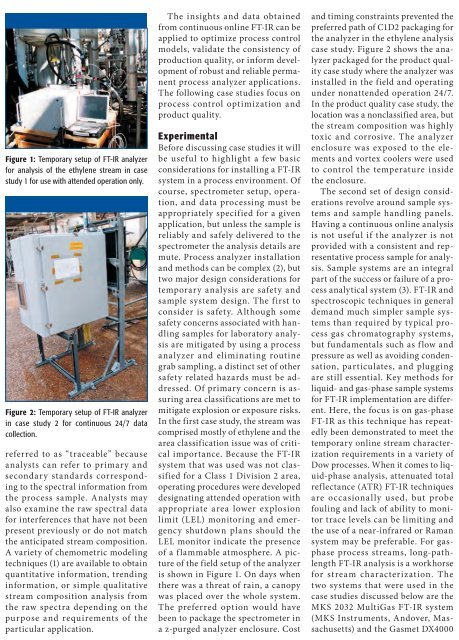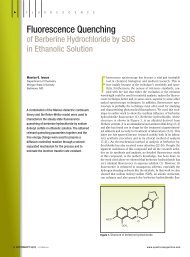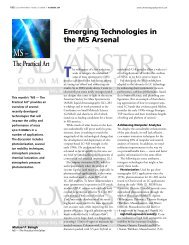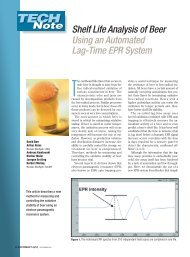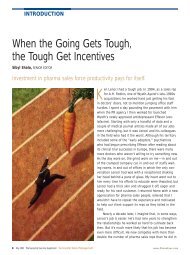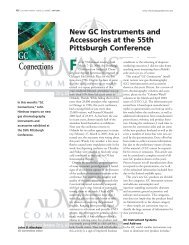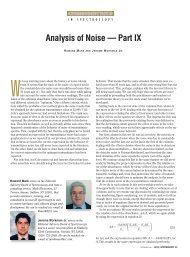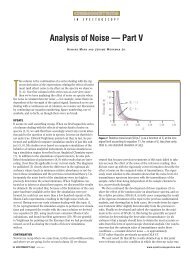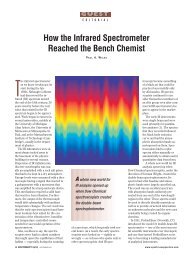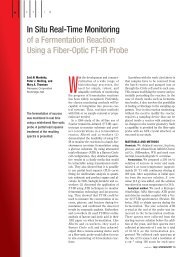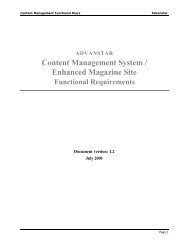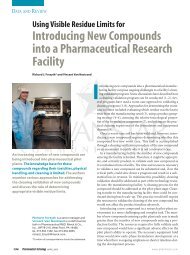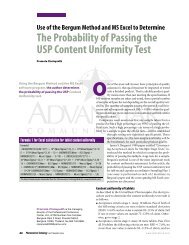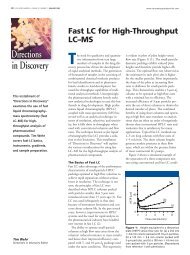2012 Corporate Capabilities - Spectroscopy
2012 Corporate Capabilities - Spectroscopy
2012 Corporate Capabilities - Spectroscopy
You also want an ePaper? Increase the reach of your titles
YUMPU automatically turns print PDFs into web optimized ePapers that Google loves.
22 <strong>Spectroscopy</strong> 26(12) December 2011 www.spectroscopyonline.com<br />
Figure 1: Temporary setup of FT-IR analyzer<br />
for analysis of the ethylene stream in case<br />
study 1 for use with attended operation only.<br />
Figure 2: Temporary setup of FT-IR analyzer<br />
in case study 2 for continuous 24/7 data<br />
collection.<br />
referred to as “traceable” because<br />
analysts can refer to primary and<br />
secondary standards corresponding<br />
to the spectral information from<br />
the process sample. Analysts may<br />
also examine the raw spectral data<br />
for interferences that have not been<br />
present previously or do not match<br />
the anticipated stream composition.<br />
A variety of chemometric modeling<br />
techniques (1) are available to obtain<br />
quantitative information, trending<br />
information, or simple qualitative<br />
stream composition analysis from<br />
the raw spectra depending on the<br />
purpose and requirements of the<br />
particular application.<br />
The insights and data obtained<br />
from continuous online FT-IR can be<br />
applied to optimize process control<br />
models, validate the consistency of<br />
production quality, or inform development<br />
of robust and reliable permanent<br />
process analyzer applications.<br />
The following case studies focus on<br />
process control optimization and<br />
product quality.<br />
Experimental<br />
Before discussing case studies it will<br />
be useful to highlight a few basic<br />
considerations for installing a FT-IR<br />
system in a process environment. Of<br />
course, spectrometer setup, operation,<br />
and data processing must be<br />
appropriately specified for a given<br />
application, but unless the sample is<br />
reliably and safely delivered to the<br />
spectrometer the analysis details are<br />
mute. Process analyzer installation<br />
and methods can be complex (2), but<br />
two major design considerations for<br />
temporary analysis are safety and<br />
sample system design. The first to<br />
consider is safety. Although some<br />
safety concerns associated with handling<br />
samples for laboratory analysis<br />
are mitigated by using a process<br />
analyzer and eliminating routine<br />
grab sampling, a distinct set of other<br />
safety related hazards must be addressed.<br />
Of primary concern is assuring<br />
area classifications are met to<br />
mitigate explosion or exposure risks.<br />
In the first case study, the stream was<br />
comprised mostly of ethylene and the<br />
area classification issue was of critical<br />
importance. Because the FT-IR<br />
system that was used was not classified<br />
for a Class 1 Division 2 area,<br />
operating procedures were developed<br />
designating attended operation with<br />
appropriate area lower explosion<br />
limit (LEL) monitoring and emergency<br />
shutdown plans should the<br />
LEL monitor indicate the presence<br />
of a flammable atmosphere. A picture<br />
of the field setup of the analyzer<br />
is shown in Figure 1. On days when<br />
there was a threat of rain, a canopy<br />
was placed over the whole system.<br />
The preferred option would have<br />
been to package the spectrometer in<br />
a z-purged analyzer enclosure. Cost<br />
and timing constraints prevented the<br />
preferred path of C1D2 packaging for<br />
the analyzer in the ethylene analysis<br />
case study. Figure 2 shows the analyzer<br />
packaged for the product quality<br />
case study where the analyzer was<br />
installed in the field and operating<br />
under nonattended operation 24/7.<br />
In the product quality case study, the<br />
location was a nonclassified area, but<br />
the stream composition was highly<br />
toxic and corrosive. The analyzer<br />
enclosure was exposed to the elements<br />
and vortex coolers were used<br />
to control the temperature inside<br />
the enclosure.<br />
The second set of design considerations<br />
revolve around sample systems<br />
and sample handling panels.<br />
Having a continuous online analysis<br />
is not useful if the analyzer is not<br />
provided with a consistent and representative<br />
process sample for analysis.<br />
Sample systems are an integral<br />
part of the success or failure of a process<br />
analytical system (3). FT-IR and<br />
spectroscopic techniques in general<br />
demand much simpler sample systems<br />
than required by typical process<br />
gas chromatography systems,<br />
but fundamentals such as flow and<br />
pressure as well as avoiding condensation,<br />
particulates, and plugging<br />
are still essential. Key methods for<br />
liquid- and gas-phase sample systems<br />
for FT-IR implementation are different.<br />
Here, the focus is on gas-phase<br />
FT-IR as this technique has repeatedly<br />
been demonstrated to meet the<br />
temporary online stream characterization<br />
requirements in a variety of<br />
Dow processes. When it comes to liquid-phase<br />
analysis, attenuated total<br />
reflectance (ATR) FT-IR techniques<br />
are occasionally used, but probe<br />
fouling and lack of ability to monitor<br />
trace levels can be limiting and<br />
the use of a near-infrared or Raman<br />
system may be preferable. For gasphase<br />
process streams, long-pathlength<br />
FT-IR analysis is a workhorse<br />
for stream characterization. The<br />
two systems that were used in the<br />
case studies discussed below are the<br />
MKS 2032 MultiGas FT-IR system<br />
(MKS Instruments, Andover, Massachusetts)<br />
and the Gasmet DX4000


